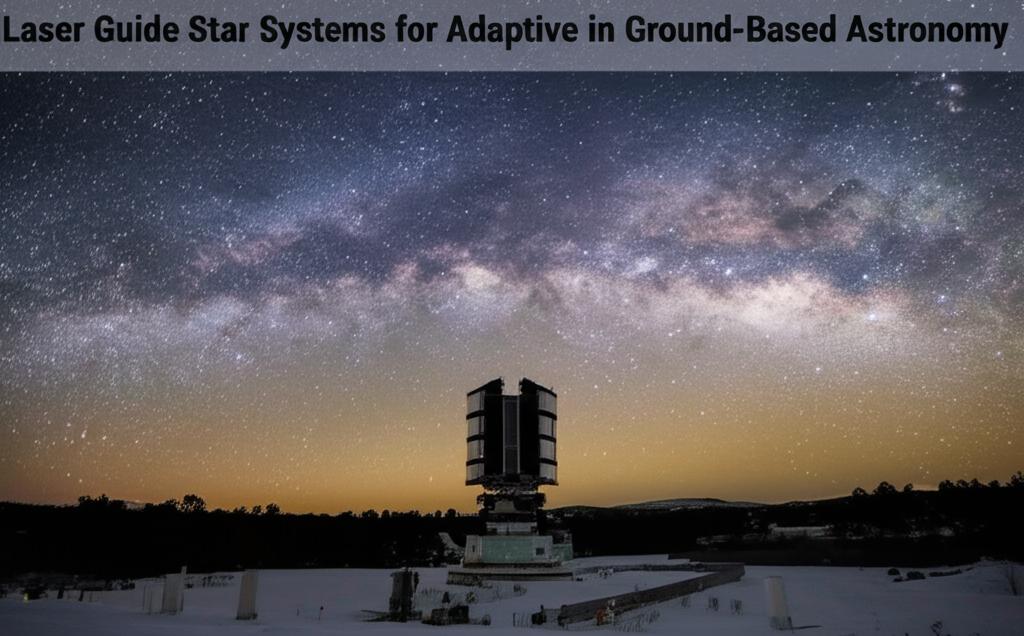Ground-based telescopes face a persistent challenge: the Earth's turbulent atmosphere blurs the light arriving from distant celestial objects. This atmospheric distortion, the same phenomenon that makes stars appear to twinkle, limits the resolution and sensitivity of even the largest telescopes. To overcome this, astronomers employ a technique called Adaptive Optics (AO). AO systems use sophisticated, computer-controlled deformable mirrors to counteract atmospheric blurring in real-time, making images significantly sharper, almost as if the telescope were in space.
Adaptive Optics systems, however, require a bright point of light – a guide star – close to the astronomical target being observed. This guide star acts as a reference, allowing the AO system to measure the atmospheric distortion affecting its light. By correcting the distortions seen in the guide star's light, the system simultaneously sharpens the image of the nearby scientific target.
Unfortunately, suitable natural guide stars (NGS) – sufficiently bright stars located conveniently close to celestial objects of interest – are scarce. This limitation significantly restricts the fraction of the sky accessible to high-resolution observation using AO systems relying solely on natural references.
This is where Laser Guide Star (LGS) technology provides a revolutionary solution. Instead of relying on chance alignments with bright natural stars, astronomers can create their own artificial star exactly where needed. This is achieved by propagating a powerful laser beam up into the atmosphere from the telescope.
Typically, these lasers are tuned to a specific wavelength (like 589 nanometers) that excites sodium atoms naturally present in a layer of the Earth's mesosphere, about 90 kilometers (56 miles) above the surface. These excited sodium atoms fluoresce, creating a small, bright spot – the laser guide star. This artificial star can be positioned anywhere in the sky the telescope points, dramatically increasing the sky coverage for AO observations.
The light returning from this LGS passes back down through the atmosphere and into the telescope. An instrument called a wavefront sensor analyzes this light, measuring the distortions imposed by the atmosphere hundreds or even thousands of times per second. A control computer calculates the necessary adjustments, instructing the deformable mirror to change its shape minutely to compensate for these distortions. This closed-loop process effectively flattens the incoming distorted wavefront, resulting in significantly sharper images of the astronomical target being studied.
While the LGS serves as an excellent reference for the shape of the atmospheric distortion (higher-order aberrations), the laser beam itself is deflected by the atmosphere on its way up. This means the LGS's apparent position jitters slightly. To correct for this overall image motion, known as tip-tilt, AO systems still usually need to monitor a nearby, albeit potentially much fainter, natural star. Measuring only tip-tilt requires much less light, so many more natural stars become suitable for this purpose, still allowing for near all-sky access for the LGS system.
The advent of LGS AO has transformed ground-based astronomy. It allows telescopes to achieve diffraction-limited performance (the theoretical resolution limit) over much larger portions of the sky, revealing finer details in distant galaxies, enabling the study of faint objects near bright stars (like exoplanets), and providing clearer views of phenomena like the black hole at the center of our Milky Way.
Laser guide star technology itself continues to evolve. Early systems often relied on complex dye lasers. Modern systems predominantly use more robust, efficient, and powerful solid-state and fiber laser technologies, such as Raman fiber amplifiers. Observatories like the European Southern Observatory's (ESO) Very Large Telescope (VLT) now operate facilities with multiple laser guide stars (like the 4LGSF), projecting four laser beams simultaneously. This multi-laser approach allows for better correction over a wider field of view, a technique vital for future survey capabilities and systems known as Multi-Conjugate Adaptive Optics (MCAO). Research is ongoing to further increase LGS brightness through higher laser power (with tests achieving over 60 Watts) and optimizing laser parameters, for example by using techniques like frequency chirping. Safety remains paramount, with systems incorporating automated aircraft detection to prevent lasers from interfering with aviation.
Laser Guide Star Adaptive Optics is no longer an experimental technique but a fundamental component of modern large observatories worldwide, including Keck, VLT, Gemini, and Subaru. It is considered essential for the next generation of Extremely Large Telescopes (ELTs) currently under construction, which will rely on sophisticated LGS AO systems to achieve their ambitious scientific goals, pushing the frontiers of astronomical discovery further than ever before from the ground.

